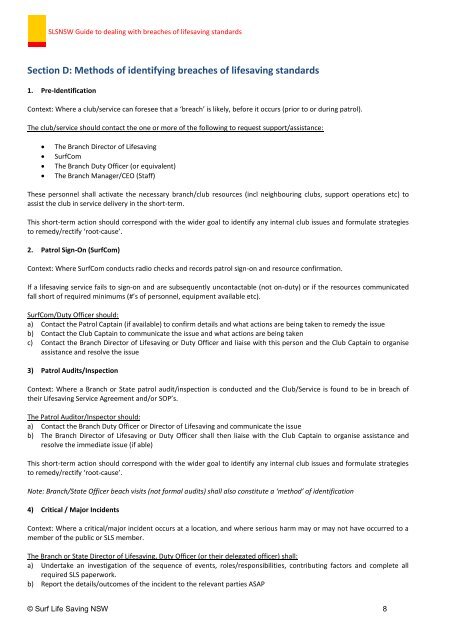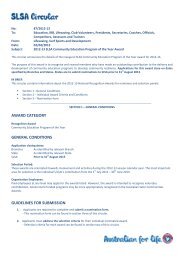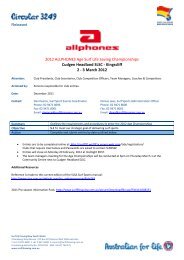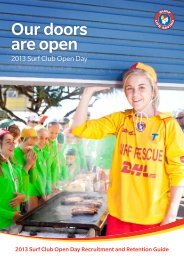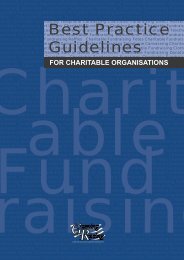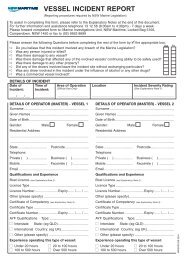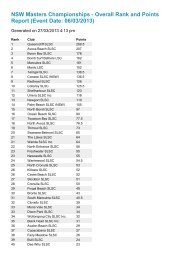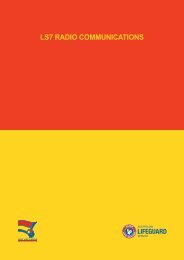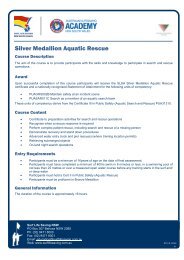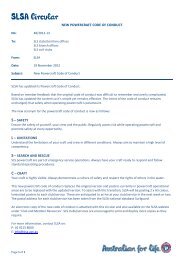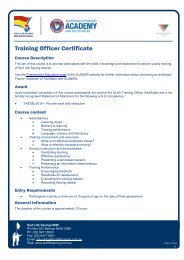a guide to dealing with breaches of lifesaving standards
a guide to dealing with breaches of lifesaving standards
a guide to dealing with breaches of lifesaving standards
You also want an ePaper? Increase the reach of your titles
YUMPU automatically turns print PDFs into web optimized ePapers that Google loves.
SLSNSW Guide <strong>to</strong> <strong>dealing</strong> <strong>with</strong> <strong>breaches</strong> <strong>of</strong> <strong>lifesaving</strong> <strong>standards</strong><br />
Section D: Methods <strong>of</strong> identifying <strong>breaches</strong> <strong>of</strong> <strong>lifesaving</strong> <strong>standards</strong><br />
1. Pre-Identification<br />
Context: Where a club/service can foresee that a ‘breach’ is likely, before it occurs (prior <strong>to</strong> or during patrol).<br />
The club/service should contact the one or more <strong>of</strong> the following <strong>to</strong> request support/assistance:<br />
<br />
<br />
<br />
<br />
The Branch Direc<strong>to</strong>r <strong>of</strong> Lifesaving<br />
SurfCom<br />
The Branch Duty Officer (or equivalent)<br />
The Branch Manager/CEO (Staff)<br />
These personnel shall activate the necessary branch/club resources (incl neighbouring clubs, support operations etc) <strong>to</strong><br />
assist the club in service delivery in the short-term.<br />
This short-term action should correspond <strong>with</strong> the wider goal <strong>to</strong> identify any internal club issues and formulate strategies<br />
<strong>to</strong> remedy/rectify ‘root-cause’.<br />
2. Patrol Sign-On (SurfCom)<br />
Context: Where SurfCom conducts radio checks and records patrol sign-on and resource confirmation.<br />
If a <strong>lifesaving</strong> service fails <strong>to</strong> sign-on and are subsequently uncontactable (not on-duty) or if the resources communicated<br />
fall short <strong>of</strong> required minimums (#’s <strong>of</strong> personnel, equipment available etc).<br />
SurfCom/Duty Officer should:<br />
a) Contact the Patrol Captain (if available) <strong>to</strong> confirm details and what actions are being taken <strong>to</strong> remedy the issue<br />
b) Contact the Club Captain <strong>to</strong> communicate the issue and what actions are being taken<br />
c) Contact the Branch Direc<strong>to</strong>r <strong>of</strong> Lifesaving or Duty Officer and liaise <strong>with</strong> this person and the Club Captain <strong>to</strong> organise<br />
assistance and resolve the issue<br />
3) Patrol Audits/Inspection<br />
Context: Where a Branch or State patrol audit/inspection is conducted and the Club/Service is found <strong>to</strong> be in breach <strong>of</strong><br />
their Lifesaving Service Agreement and/or SOP’s.<br />
The Patrol Audi<strong>to</strong>r/Inspec<strong>to</strong>r should:<br />
a) Contact the Branch Duty Officer or Direc<strong>to</strong>r <strong>of</strong> Lifesaving and communicate the issue<br />
b) The Branch Direc<strong>to</strong>r <strong>of</strong> Lifesaving or Duty Officer shall then liaise <strong>with</strong> the Club Captain <strong>to</strong> organise assistance and<br />
resolve the immediate issue (if able)<br />
This short-term action should correspond <strong>with</strong> the wider goal <strong>to</strong> identify any internal club issues and formulate strategies<br />
<strong>to</strong> remedy/rectify ‘root-cause’.<br />
Note: Branch/State Officer beach visits (not formal audits) shall also constitute a ‘method’ <strong>of</strong> identification<br />
4) Critical / Major Incidents<br />
Context: Where a critical/major incident occurs at a location, and where serious harm may or may not have occurred <strong>to</strong> a<br />
member <strong>of</strong> the public or SLS member.<br />
The Branch or State Direc<strong>to</strong>r <strong>of</strong> Lifesaving, Duty Officer (or their delegated <strong>of</strong>ficer) shall:<br />
a) Undertake an investigation <strong>of</strong> the sequence <strong>of</strong> events, roles/responsibilities, contributing fac<strong>to</strong>rs and complete all<br />
required SLS paperwork.<br />
b) Report the details/outcomes <strong>of</strong> the incident <strong>to</strong> the relevant parties ASAP<br />
© Surf Life Saving NSW 8


